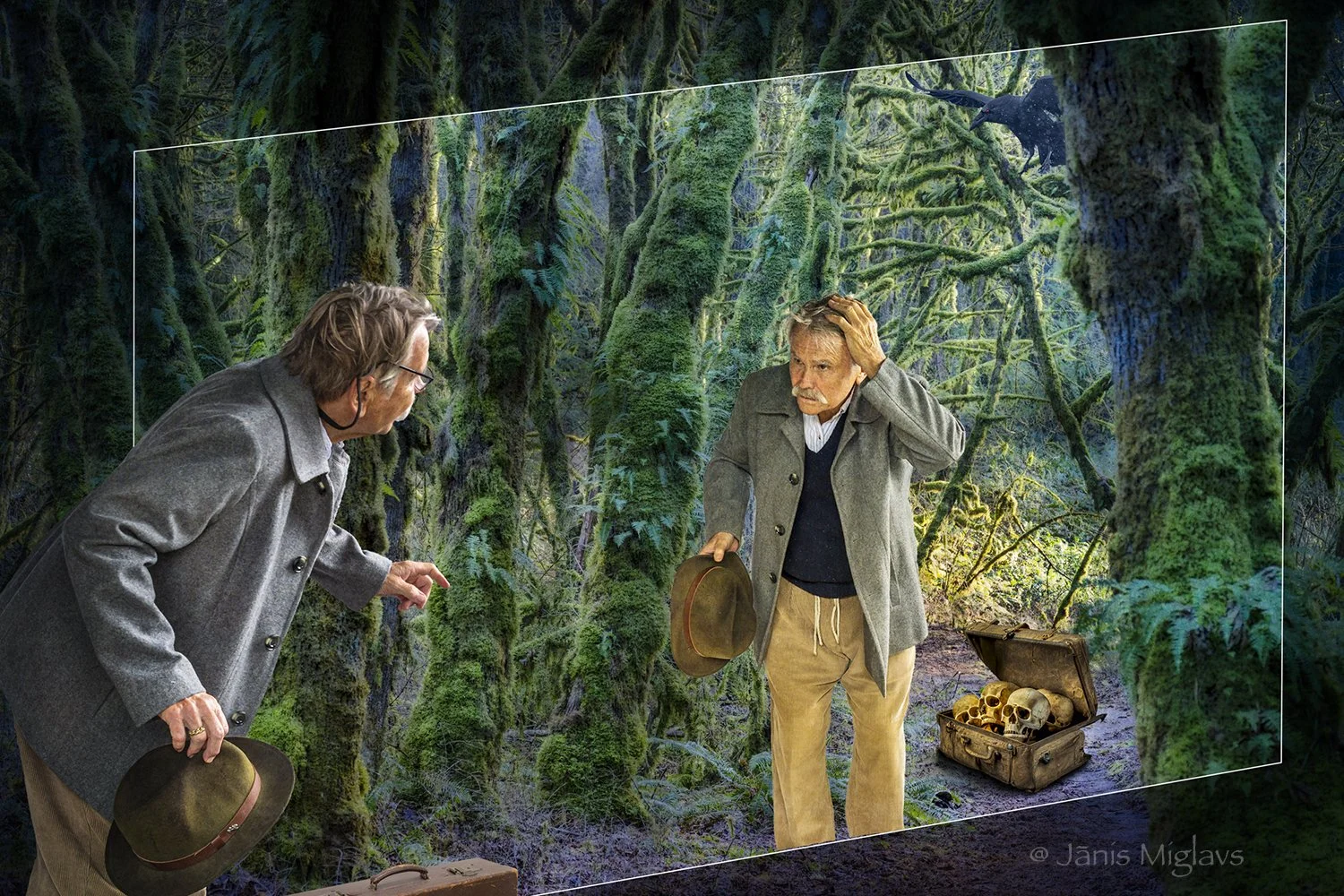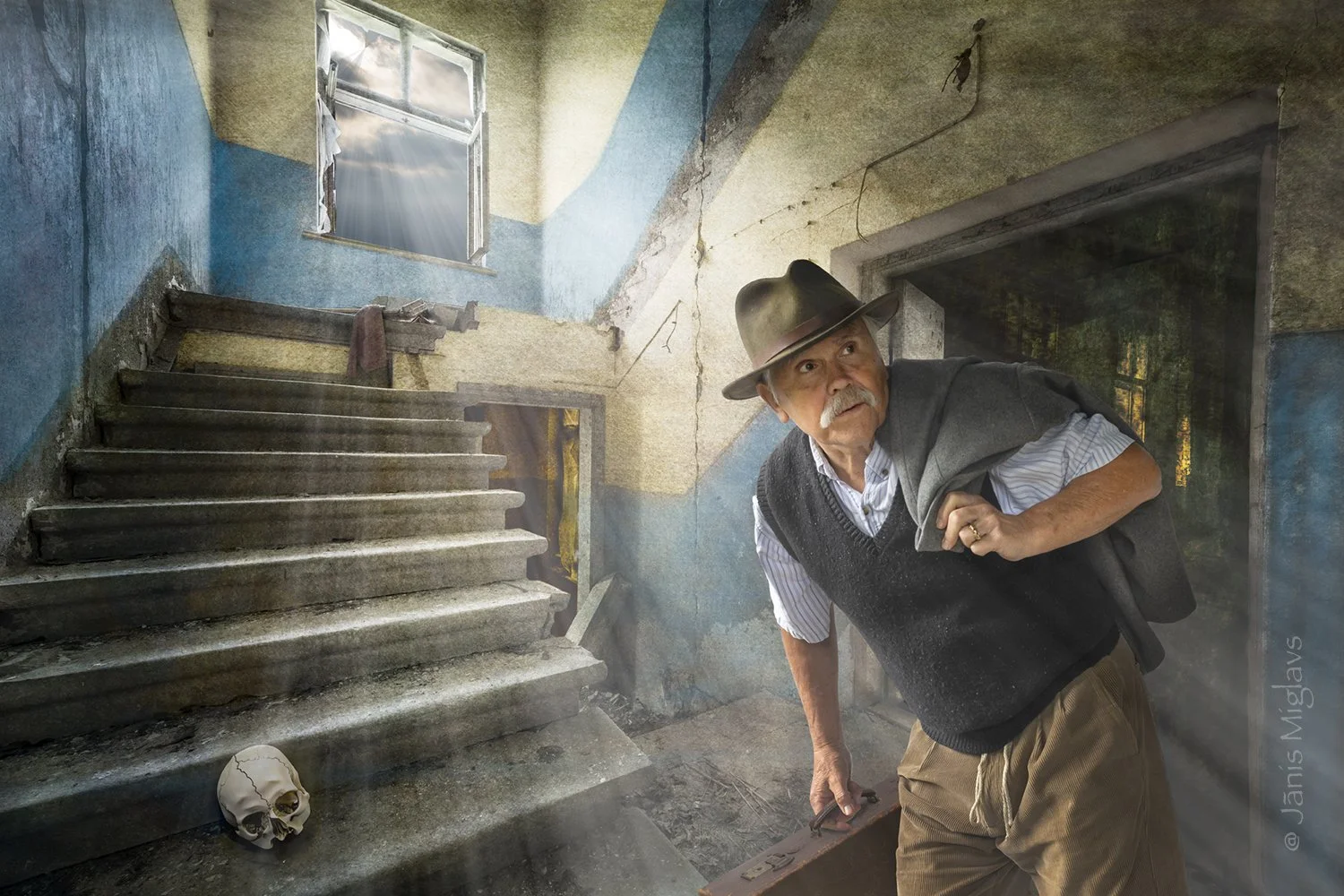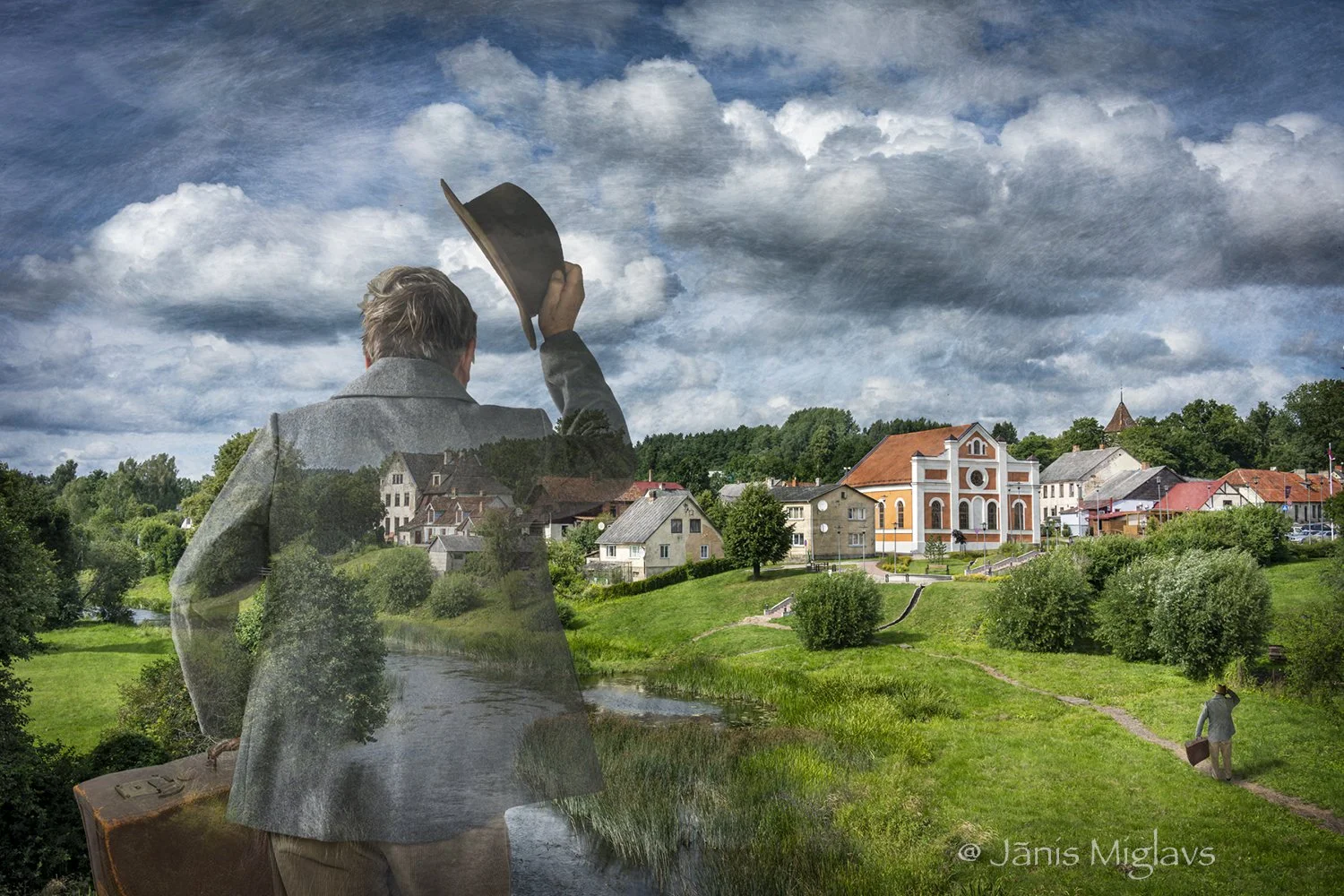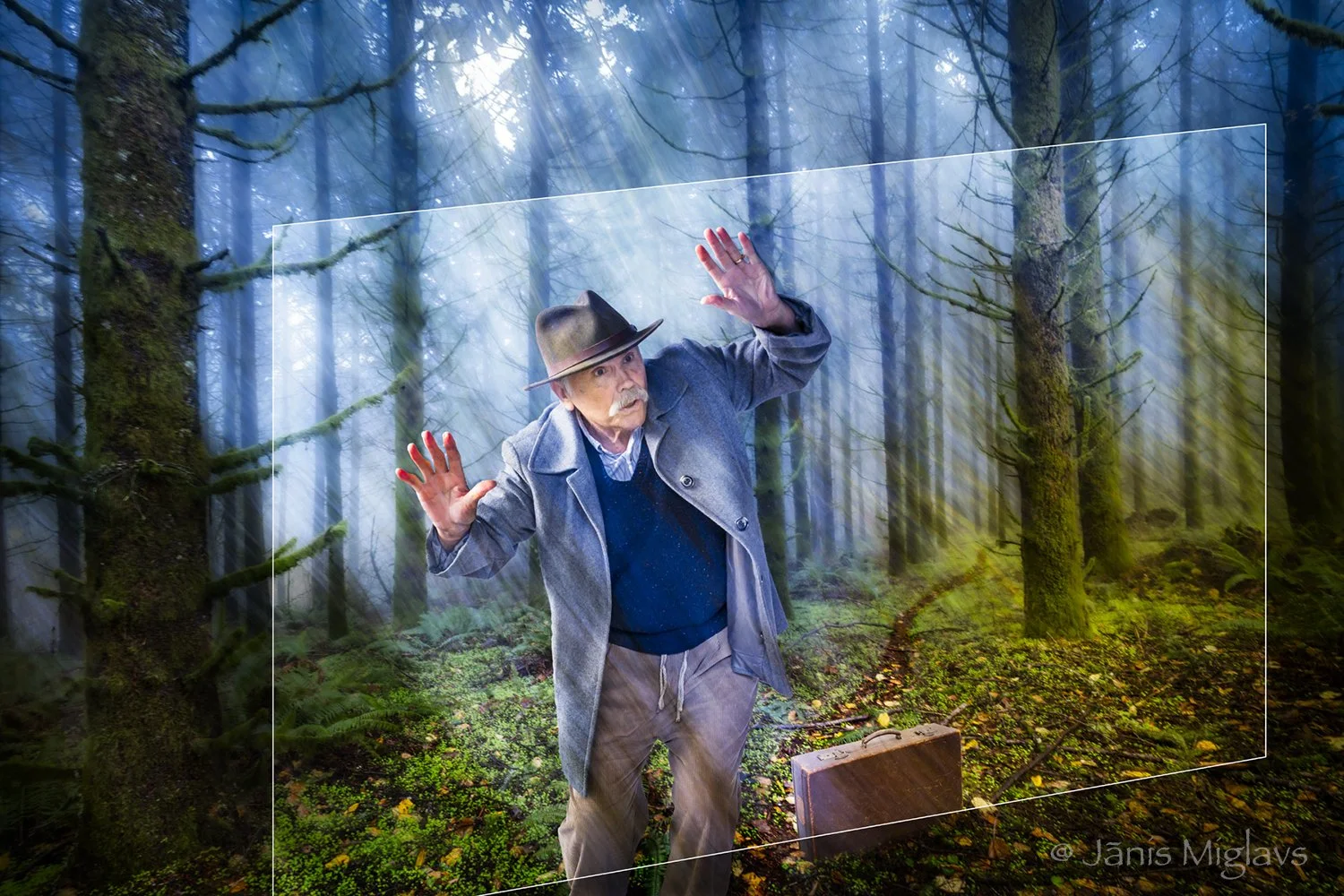Immigrant’s stories for his grandchildren
Who am I?
My parents fled certain death when the Soviets invaded Latvia.
Oh, the stories. Burying valuables in the forest, leaving home in a horse drawn cart,
dodging bombs and bullets for months, searching for food and shelter each day.
How much of that trauma is passed on to their children, my sister and I?
I was born in a displaced persons’ camp. Immigrated to the United States.
That first day of school, I learned my very first English word: pencil.
I so desperately wanted to become American but still had to go to Saturday Latvian school.
How much of those experiences shape me? Insecure? Shy?
In my thirties, I finally went to Latvia. I cried. No, I sobbed. My whole body shook.
I was born without a home. Walking on Latvian soil felt like returning home. A deep home.
And our mysterious ancient family roots trace back in Latvia to at least the 1700s.
How much of that is part of my deep unconscious memory?
So I create images and recall stories to help me understand the source of those tears.
To help me understand how ancestors and culture make me the composite I am today.
To even help me understand what it means when DNA tells us that we, all of us “modern” humans, are Immigrants out of Africa some 100,000 years ago.
Aren’t we all immigrants?
Searching for clues
How much do Ancestors affect the inner landscape of who I am today? That’s one of the core questions I’m trying to answer for myself. The more I rummage through my ancestral compost pile, the more I find rich soil sprouting this person I am right now.
Mom It wasn’t until after my mom—Zina—died, did I realize all the colors she painted in my life. She was a school teacher in Latvia and in the displaced persons’ camps where we lived after escaping the Soviets. In America, she continued not only patiently teaching my sister and I all of her life, but also her grandkids. In our Napa, California, house, she made Latvian dishes and deserts. Neighborhood kids always hung out at our house for the treats. Small wander that at her memorial, the church was filled with adults who were kids I grew up with.
Something, some unspoken Siren, called me to visit the abandoned Ipiki school house not far from our Latvia family farm. I wandered into memories.
Weaving Memory with Life With this Immigrant’s Journey Project, I’m like a lighthouse searching for new ways to combine foggy memories with everyday life into a single image. How to do that? My wife Eddi’s creative quilts provided God-light inspiration.
So now I’m physically weaving two or three printed-on-special-paper photographs into one image. (Since they are very 3D tactile, the actual prints present much better than 2D screen presentations.) Keep in touch for upcoming gallery shows.
When the Sirens call your heart, a Journey of Discovery begins.
The Immigrant begins the Journey
The First Step What was that stirring in my heart? What did it hear? It had been 28 years since my last journey to homeland Latvia. Now I needed to undertake a pilgrimage to touch deep cultural roots, to meet relatives I didn't know I had, to revisit our family farm. Taking the first footstep toward a homeland journey, to going home.
But where exactly is your home? Where do you start any journey?
Arriving covered with American dust On my most recent trip to Latvia, the Bolt (Europe’s answer to Uber and Lyft) driver told me that my Latvian was perfect, but I had an American accent. Wait. How did that happen? My first language was rural Latvian. California English was my second.
Yea. And why in Germany, people knew I was American just by my clothes? And why in some world countries I travel with my EU passport because Americans are despised?
So how did this American dust cover me like dandruff?
Latvia’s Siren Song What was that feeling? Awakened me in the night? Touching me like moon light through the bedroom window?
How could an ant-sized noise in my heart propel me to return, as an immigrant. Searching for roots, What is this Siren song that makes a postage-stamp-size country feel like home?
On that bumpy potholed journey of discovery, I found a beautiful Latvia. One that made my heart sing. I could easily live in this village called Sabile on the Abava River. They even have a vineyard. What more could I ask for?
Homecoming
Searching the ancestral compost pile
Searching Sometimes, when I’m in Latvia I wander the village streets where mom grew up. Looking. Feeling. Trying to touch something we discard as the past.
Why?
Perhaps to unearth weathered ancestral roots that provide the compost, the rich nutrients growing the person walking those very streets today.
Looking for Mom, my roots When my mom started high school, she bicycled the 10 miles to Rujiena, the biggest village in the area. But in the freezing snow. No. So she moved to Rujiena.
On my last trip to Latvia, I spent a week in Rujiena often wandering the streets wondering what it must have been like for her inner life? Alone? Away from family? Away from home?
One evening while strolling on Skolas iela (School street), a puffy cloud of realization engulfed me. I don’t mind being alone. In fact, I enjoy it. I most often travel alone. And I love getting on my bicycle to see the world. Wow, mom, you passed on more than I ever realized. Thank you.
What colors did the Soviet Communist boot prints leave in Latvia?
Is there a future? I felt it as soon as I got off the airplane in Riga. During my first return trip to Latvia I experienced the heavy air from 50 years of Soviet occupation. A leaden grayness smothered everything. This little girl’s oblivous stare perfectly summerized the effects I saw on people.
Recalling little joys (The recovery power of the Human Spirit) Looking at the photograph of the child running towards mother I took when the Communist occupied Latvia reminded me of all the hardships during that time, but also the little joys.
I recall standing in a long line outside the dairy store to buy a bottle of milk. Just one liter. When I finally got to the counter, they were completely sold out. Not a single drop left. (Obviously some dairy collective in the failing Soviet system did not produce their quota, even if their records showed over production.) I left frustrated.
Then I strolled down the street to see this girl running to greet her mother after school. Oh, how that little girl’s joy lifted my spirits. No milk today, but there’s still joy to be found around the corner.
Can you imagine your Honeymoon as a life-long Escape when Soviets took your home?
Just married. Then flee for your life. When I took a walk along the gravel road that bisected our Latvian family farm towards the Estonian border, I stopped by an abandoned farm house. Since my parent’s house had long ago crumbled from Soviet-period neglect, seeing this neighboring house opened the corral to a herd of thoughts, wonderings.
Mom and dad married in 1943. (See mom’s hand-written wedding invitation in the photograph. “Please honor us with your presence at our wedding in Rūjiena’s church.”)
Oh, that first year of marriage. Constant rumbling of War. First the Russian Soviets invaded. Dad’s brother killed. His nurse sister sets up a hospital in her own home. Then the Nazis flooded in. When the Soviets started to push the Germans out, it was decision time.
Fearing for their lives, less than a year after the wedding day, mom and dad fled the tsunami-like Soviet invasion. Packed a few necessities, maybe a handful of photos, into a horse-drawn cart. Buried some things. Then left their home. Left Latvia. Left forever.
So, in front of this abandoned house neighboring our Latvia family farm, I let my mind drift. What kind of thoughts ravaged mom and dad during those first steps of their exodus?
Hope Imagine living in various crowded displaced persons’ camps with blankets for walls for more than five years. That’s my parents’ experience and with two young kids (my sister and me). There were thousands of others in those camps. Imagine the hope my parents must have felt when we were accepted into the United States. I can now only imagine the similar experiences of Ukrainian and other refugees around the world.
How did America shape me, the Immigrant?
Becoming an American Cowboy As an immigrant kid I really wanted to become an American. That meant speaking only English and being a cowboy. How did I ever learn that stereotype, that cultural myth? Today I see "adult" men strutting with real guns in the street. So are they living out the same stereotype of the rugged individual with a gun I wanted to emulate as a kid? Can we grow up and out of stereotypes learned as a child? And what cultural stereotypes or myths did you emulate as a kid?
Emerging from a forest of unknown infant memories
Mom and dad told me I spent my infant years in two displaced persons’ camps in Germany, Itzaho and Eutin. Looking at photos of DP camps, a gentile wind whispers through a dark forest, stirring something untouchable deep inside. But not a single picture or word is recorded in the memory album. Yea, something about the brain’s hippocampus not being developed enough to process the pictures of life.
I know some who are fortunate not to have clear cognitive memory of terrible events during those foggy years. I sense I’m fortunate.
Yet, surely those memory mystery years left inky fingerprints on me.
Memories meet reality During my last homeland Latvia visit, I really tried to re-imagine scenes from my parent’s stories and memories. It’s been just over three quarters of a century since they buried their valuables and escaped Latvia.
As I stood in their last footsteps, I couldn’t help but tear up imagining their pain. Now a handful of photographs they managed to stuff into bags loaded onto a small horse-drawn cart are my family archeological treasures, helping me match memories with a past reality. Helping me to picture my family reality.
Found Pencil: The beginnings of Human Civilization Napa, California. First or second grade.
I arrived to my first American school with a dozen English words in my mouth and my only possession clipped in my pocket—a mechanical pencil.
During recess, we kids played in the neighboring field. One day back in the class, still sweaty from running, I felt my shirt pocket for the pencil. Gone. I felt for it again. Still gone.
Did I actually cry? (Surely I hadn’t learned yet that American boys don’t cry) or just looked like a sack of sadness staring at my empty pocket. Yet somehow the teacher understood a Universal Language without words. She stopped our lessons. Marched the entire class out to search the city block size field of dry knee-high weeds.
Searching. Searching. “Found it,” yelled one of the kids. I didn’t know his words, But I understood what he said. For me, he had found the long lost sheep.
Many years later, I read a lecture by anthropologist Margaret Mead. A student asked what was the first sign of civilization. Agriculture? Clay pots? Grinding stones? iPhones?
“No,” Mead replied. In fact, it was a broken femur that had healed. That was evidence that someone tended that person to recovery, to survival. “Helping someone else is where civilization starts,” according to Mead.
Thank you second grade teacher, my cultural femur healer. Besides English, you taught me the beginnings of human civilization: kindness.
Mindful of our footprints Latvia America Africa
Anthropologists and DNA tell us that we, all of us Modern Humans, migrated out of Africa some 60,000 to 100,000 years ago. How far have we as human immigrants come since leaving the original Homeland?
Today I have been given the world by people who had less than I have. What foot prints do I want to leave on our planet, for my grandchildren, and for their grandchildren?



















